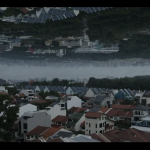Student Bodies
2019 - Film & Video (Film & Video)
26:30 minutes
Ho Rui An
Embracing the conflicting negative and positive affect of the horror genre, Ho Rui An’s film Student Bodies is a self-described work of “pedagogical horror,” that organizes social, political, and economic events in Asia around the motif of the student body. Bound together by a suspenseful, eerie soundtrack, the film temporally cycles through its separate, though thematically interrelated, phenomena and events centering Asian students. Using the student body motif as a human signifier of varied connotations, the film follows phenomenon ranging from the Ch?sh? Five (the first five Japanese students who left to study in Britain during the late imperial period known as the Tokugawa Shogunate) to the 1976 Thammasat University massacre in Bangkok, Thailand, during which upwards of 100 student protestors in Thailand were murdered by state forces. Employing horror genre tropes to produce a speculative, historical assemblage about Asia, Student Bodies generates a newly affective take on the trend of historical genealogies in contemporary art. Centering a relatable motif, the film drags the viewer into developing a personal stake in its eerie constellation, displacing the empathetic, patronizing attitude towards Asia, characteristic of neo-Orientalist sentiment. Ho’s use of horror genre strategies to describe Asia ironically invokes Western discourses of the “Yellow Peril”, a racist color-metaphor that is integral to the xenophobic aspect of colonialism. The film disputes conventional narratives of Asian modernization and radicalism, revealing the human strands intertwined within the greater socio-political webs of Asian nation-states. The horror genre thus becomes an uneasy affective tie, that forces the viewer into generating emotionally disconcerting affinities between the film’s disparate historical moments. The “horror” of pedagogy is exposed, dissolving totalizing narratives in its wake, even as the film reveals the precarity of its liminal, imaginative connective threads.
The artist, writer, and researcher Ho Rui An probes histories of globalization and governance, performing a detournement of dominant semiotic systems across text, film, installation, and lecture. Ho’s work investigates the emergence, transmission, and disappearance of images within the contexts of liberal hospitality, participatory democracy, and speculative futures. Questioning the borders between pedagogy and artistic practice, image and meaning, Ho’s artistic output diverges from traditionally structured postcolonial critique, proposing new frameworks for artistic and scholarly innovation. Breaking from Western avant-garde paradigms of performance lecture as immanent critique, Ho’s practice generally explores the latent potential in imaginatively refigured pedagogy as both a medium and subject. His performances are intricate, genealogical tracings of the means by which diverse images of power across Asia find surprising relations, moving freely across topics and sources. His works are often installed as sculptural extensions to his performance lectures, incorporating additional mediating factors for the audience’s experience, including idiosyncratic seating, backdrops, or physical props.
Colors:
Other related works, blended automatically
» see more
Other works by: » Ho Rui An
» see more
Related works found in the same semantic group
» see more

© » WHITEHOT
Nelson Loskamp reflects on years making paintings from horror stills advertise donate post your art opening recent articles cities contact about article index podcast main February 2024 "The Best Art In The World" "The Best Art In The World" February 2024 Nelson Loskamp reflects on years making paintings from horror stills Artwork by Nelson Loskamp...

© » ARTS EQUATOR
SEE WHAT SEE (Mar 2021): GENRE FICTION | ArtsEquator Thinking and Talking about Arts and Culture in Southeast Asia ArtsEquator Viewpoints March 30, 2021 By Joel Tan Welcome back to See What See ! It’s our monthly round-up of interesting stuff by Singapore and regional makers that you can stream right here on the Internet...



